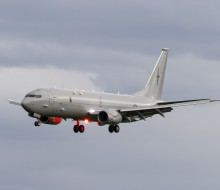
Anzac Day Flypasts 2024
23 April 2024
Unfortunately you are viewing this website on an outdated browser which does not support the necessary features for us to provide an adequate experience. Please switch to a modern browser such as latest version of Google Chrome, Mozilla Firefox, Apple Safari or Microsoft Edge.
Ngā mihi nui
It’s all about storm chasing when you want to find out the limits a helicopter can operate within, from a ship.
Last month, maritime sustainment ship HMNZS Aotearoa passed its First of Class Flight Trials in partnership with No. 6 Squadron for the operation of a Seasprite SH2-G(I) maritime helicopter from its flight deck.
The achievement means Aotearoa, the Royal New Zealand Navy’s newest ship since commissioning in 2020, is qualified to embark a Seasprite and use it for operations and exercises.
Every class of ship capable of embarking and operating a helicopter needs to conduct trials to ascertain Ship Helicopter Operating Limits (SHOLs) – the safe limitations for a specific helicopter type flying to and from that particular class of ship.
The trials experiment with wind direction, ship movement and weight parameters for launching and recovering that helicopter, by day and night.
The ship’s company and the flight crews have to learn how the wind behaves in relation to the superstructure of the ship and its course and speed, which could alter wind direction and strength over the flight deck. There’s also the ship’s roll and pitch to take into account, depending on how the ship is pointing into the relative swell.
Both the ship and Seasprite were fitted with precision instrumentation to correlate relative wind speed and direction with the helicopter’s performance. Readings of engine thrust, rotor torque, landing force and other parameters were taken into account.
The more variable and challenging the weather, the more complete the data gathered will be. Cruising around the Hauraki Gulf isn’t going to be enough.

First Of Class Flight Trials for HMNZS Aotearoa | Royal New Zealand Navy
“We were lucky with the weather,” says Aotearoa’s Ship Information Officer Ensign Emma Walker.
“We didn’t have to search too hard for rough seas and high winds.”
Training Flight Commander Lieutenant Commander Matt Snazell says the difficulty with the ship moving was working out where the waves were coming from.
“Aotearoa is such a big ship it’s quite difficult to tell. You see the swell break over the bow of the ship, but then it takes few seconds for it to get to the flight deck at the very end. You’re really just having to sit and wait for the opportune moment.”
“We did spend quite a lot of time going up and down with the ship and it looked quite hectic from the flight deck as it looked like we were moving all over the place,” he says.
The training enabled the helicopter crews to find the “edge of the night flying capability” – and they found it.
“We had a few issues with really strong winds and turbulance coming over, so we worked out there were certain areas we couldn’t use. We can’t have winds from a certain direction or at a certain strength.

“Strong winds from a really tricky direction means it’s not safe to oprate the helicopter, so that’s where we drew the line,” LTCDR Snazell says.
The crew used a combination of night vision goggles and flying unaided, using the lights from the ship.
Commander Rob Welford, Commanding Officer Aotearoa, says the trials took nine days.
“Finding the operating limits required the ship to seek out bad weather and this was achieved with the help of a meteorologist on board. A large swell was encountered near Cape Reinga, and strong winds off the East Cape.
“The biggest waves were eight metres high, our largest roll was nine degrees and largest pitch was 5.7 degrees.”
The trials required 28 hours of flying, 181 deck landings, plus 41 other trials such as transfer simulations and refuelling.
“It’s also a very good test of the ship’s organisation and ability to coordinate flying operations in all variations of weather and sea states,” Commander Welford said.